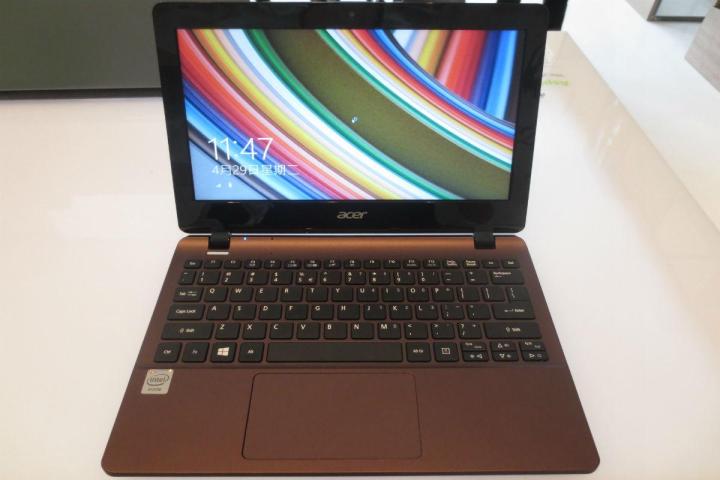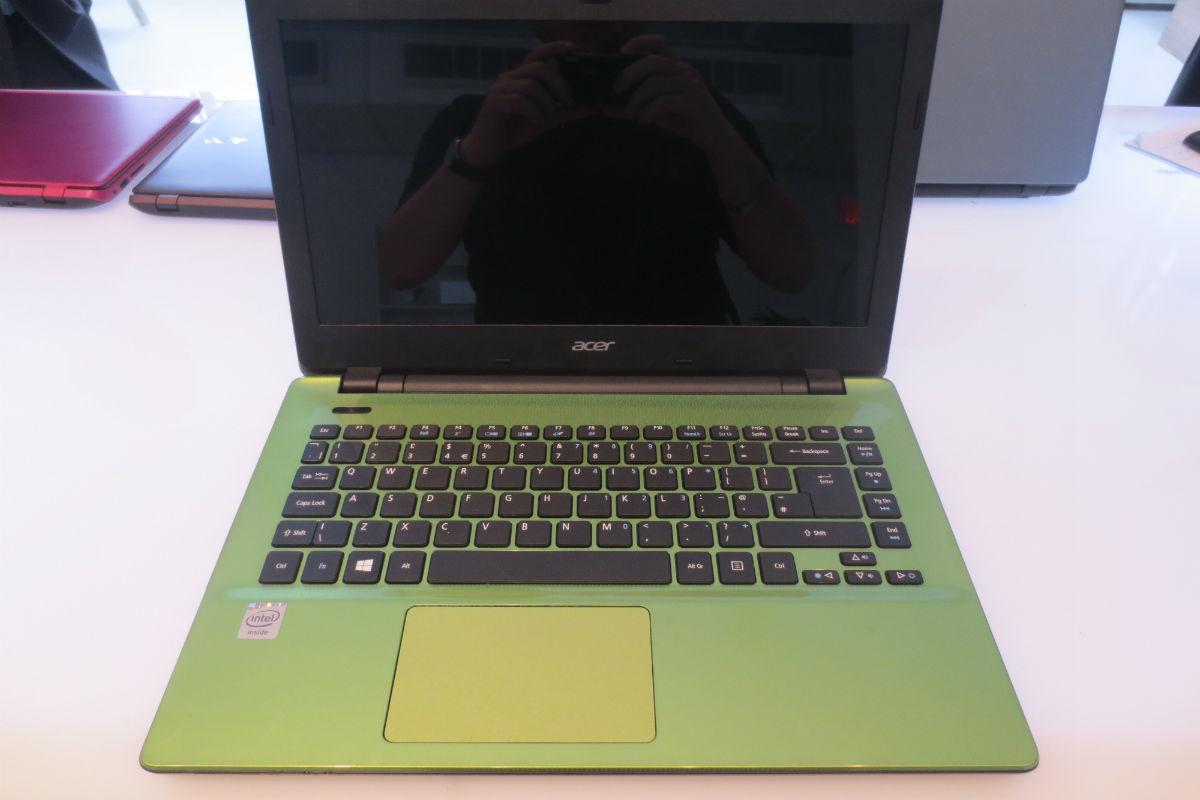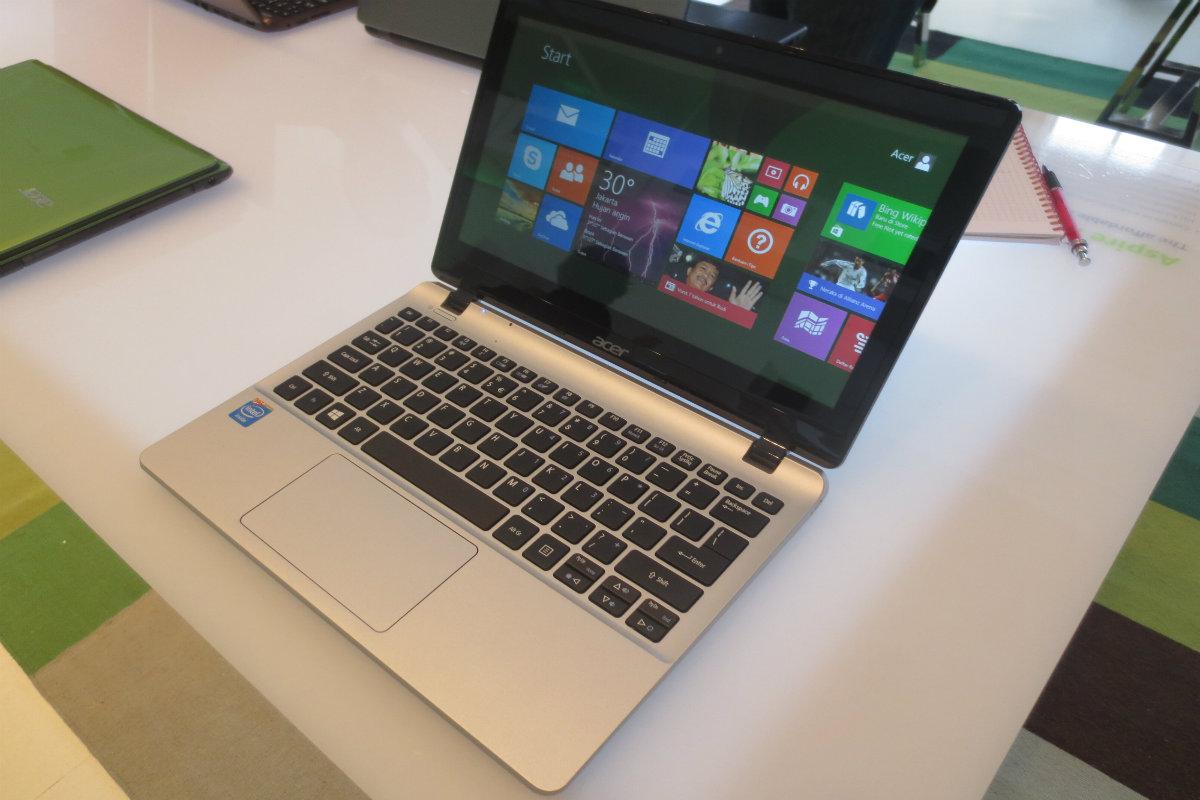
At Acer’s press conference today here in New York City, we got to check out some of the company’s newest PC hardware, which includes a slew of budget-priced notebooks, along with a pair of all-in-one desktops.
As we strutted through the product demo rooms that Acer had set up, the two words that came to our minds as we handled the firm’s newest systems were “basic” and “budget.” However, we were far from shocked, considering that these two words are consistent with the company’s tradition of making products targeted at value-oriented markets.
We started off with the Aspire E 14 and E 15 series of notebooks, which sport 14-inch and 15-inch displays (as you might have guessed from the names), and weigh between 5.07 pounds and 5.95 pounds; figures that don’t paint a picture of uber-portability. For instance, the 15.6-inch Dell XPS 15 weighs 4.4 pounds, though, to be fair, it is priced significantly higher than any laptop Acer showed off today.

Meanwhile, the 11.6-inch Aspire E 11 and Aspire V 11 laptops, which were the smallest laptops of this new bunch from Acer, weigh 2.85 pounds and 3.06 pounds. Those figures are about right for systems of this size.

Constructed mostly of plastic, none of these systems felt particularly sturdy either, and we didn’t get the impression that they could sustain heavy amounts of damage.

All of Acer’s new Aspire notebooks are outfitted with the company’s “Precision Touchpad,” which, it claims, offers a smoother touchpad experience when compared with what was equipped with past Acer notebooks. When we gave the touchpads a spin, we found that executing gestures like pinch, stretch, and scroll in Windows 8.1’s Metro UI were easy and smooth to pull off.
Dragging files around in the classic desktop UI didn’t reveal any serious issues either, though the touchpad experience in the tiled interface was noticeably more pleasant. The typing experience was also solid across the board as well, with the Aspire E 15 Series offering the most spacious keyboard, complete with a full numpad.

We went around from one system to the next, typing whatever came to our minds in Wordpad, and we committed very few errors. On the touchscreen-enabled models we used, navigating back and forth between the two UIs, and performing gestures, was a cinch.
From a design standpoint, the two notebooks that stuck out to us most were the Aspire E 11 and the Aspire V 11, both of which wear upward-sloping curves towards the top of the keyboard deck.

The V 11 also wears a layer of aluminum alloy on its lid, which gives it a somewhat premium feel. The curves on these two systems and the metal coating on the V11 adds a bit of flair to a group of systems that otherwise, as we said, look pretty basic.
Now, onto specs. All of these notebooks will offer a range of AMD and Intel processors, from low-end Celerons and Pentiums, to faster Intel Core i and AMD A6/A10 chips. Save for one non-touch version of the Aspire E15, all of these laptops will be equipped with 1366 x 768 screens. Like we said, “basic.”
Memory can be maxed out to 8GB on the E 11, V 11 and E 15 ES1-511, while all other versions of the E 15 series, and all instances of the E 14, can be configured with up to 16GB of RAM. However, we feel that anything over 8GB would be overkill. Storage maxes out at 1TB on all of the company’s new Aspire E- and V-series laptops.
On the desktop front, Acer had a total of two new models to show off: the Aspire U5-620, and the Z3-615 (the photos below are arranged in the order in which the systems are mentioned here).


We found the Z3 to be quite bulky around back, which made us wonder whether it had a desktop-class graphics card stuffed inside. However, once we peered into Windows 8’s “Device Manager” screen, we learned that the unit we used was actually equipped with Nvidia GeForce 840M graphics instead (the 800M series is a mobile-class line of GPUs).

The Aspire U5, on the other hand, was significantly thinner, and can be placed flat on a table, which could make for an interesting way to show off photos from your latest vacation to visiting friends and family. Both AIOs ship with barebones mice and keyboards, which don’t offer any eyebrow-raising features, but will simply get the job done.

Despite the seemingly greater amount of bulk worn by the Z3, both systems pack 23-inch 1080p screens and weigh roughly the same: 17.42 pounds for the Aspire U5, and 17.2 pounds for the non-touch version of the Z3. Getting the touch-enabled flavor of the Z3 bumps its weight up by almost two pounds though (19.3).
One potential annoyance we noticed on the U5 was the placement of its ports, which are located around back and underneath where all its components are housed. It could be quite a pain to plug any cables or peripherals into the U5, considering its connections aren’t exactly located on an easily-accessible part of the system.

On the specs front, both the Z3 and the U5 will offer significantly less variety in terms of CPU choice than Acer’s newest notebooks will. The U5 can be outfitted with an Intel Core i3, i5 or i7, and the same goes for the Z3, although the latter will also offer lesser Pentium and Celeron chips as well. Both can be stuffed with up to 16GB of RAM, but as with the notebooks, we feel that 8GB will suffice. Storage starts at 500GB for both desktops, and tops out at 1 TB, though the U5 will also give you the option of stuffing in a hybrid drive with 8GB of flash.
The entry-level versions of the Z3 and U5 will include integrated Intel GPUs, though those can be stepped up to Nvidia GeForce 840M and 850M graphics cards, which can make gaming viable on either system. However, you shouldn’t expect to be able to crank up Crysis 3 to the max on either system, even with these dedicated GPUs in tow.
As we mentioned, all of these rigs, save for the desktops, are priced at dirt-cheap rates. The Acer Aspire E 11 and V 11 will be available in June starting at $269.99 and $369.99, respectively. The Aspire E14 and E15 series will start at $299 and should hit the market sometime beginning in June. As for the desktops, the Z3 will start at $599.99, and the U5 will carrying a base-level asking price of $999. Both of these AIOs will also be available in June as well. All of the systems are targeted at the back-to-school crowd, and considering what books and tuition typically cost, making extremely cheap notebooks could pay off for Acer.
It’s no secret that Acer has fallen on some hard times as of late, suffering a 14.8 percent drop in PC shipments during the first quarter of this year, as well as a $251 million loss during the fourth quarter of last year. Comments made in January by Jason Chen, the company’s new CEO, included statements that the company made too hard of a push into touch panels and Ultrabooks, which contributed to the company’s slump, he claimed. This made us wonder whether the company would go in a more budget-focused direction on the PC side of its business. If today’s event is any indication, it appears that’s definitely the case.
Though the company has indeed put a greater effort into making more high-end products, like the excellent Acer Aspire R7 notebook, overall, the company’s history from a PC standpoint has traditionally been with budget-priced laptops and desktops. With today’s Acer press conference in the books, it’s clear that the company has strengthened its commitment to serve budget-minded consumers.
Editors' Recommendations
- Acer gets serious about 14-inch gaming laptops
- Acer’s new gaming laptop bring Nvidia RTX 40-series GPUs under $1,000
- Acer’s new Predator Orion X is an RTX 4090 desktop I might actually buy
- Acer Swift Edge vs. Microsoft Surface Laptop 5
- The new Acer Swift 3 is an OLED laptop for just $900


